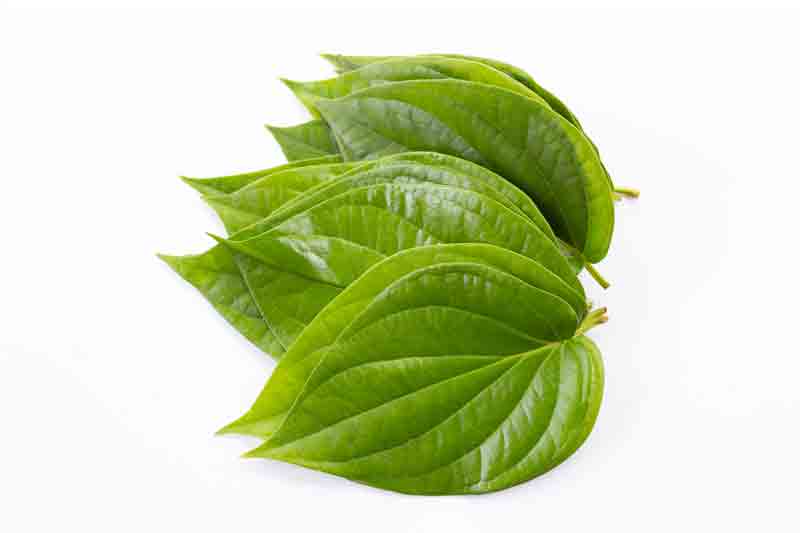Quick Facts
Botanical Name: Piper betle
Family Name: Piperaceae
Common Name: Betel
Part Used: Leaf
Specific Gravity: 1.0440 to 1.0540 at 30oC
Optical Rotation: (-) 1.5 To (-) 4 at 30oC
Refractive Index: 1.500 To 1.5240 at 30oC
Blends Well With: Clove, Cardamom, Cinnamon
Uses: Betel leaf oil has invigorating properties. This oil is also used as a deodorant component.
Countries Where it is Found
The betel vine is cultivated predominantly in South Asia and South East Asian countries, where India is the leading producer.
Harvesting Information
The plant is a perennial creeper and requires high land and fertile soil for growth. The creeper is harvested during the monsoon season. The vine reaches around 150 to 180 centimetres before being harvested. The harvest lasts for fifteen days to one month.
History of the Plant
The plant is believed to have originated in the Malay Archipelago and later spread through tropical Asia and Malaysia. Its use dates two thousand years back. Betel vine cultivation began in South Asia with India producing about Rs.7000 million annually.
 Extraction Process
Extraction Process
Fresh betel leaves are steam distilled to obtain the oil. The leaves are partially before extraction process. Young leaves give the highest yield. The oil is usually medium brown to bright yellow in colour depending on the type of leaf used. The odour is sharp and the taste bitter.
Commonly Known Benefits
Medicinal Benefits
Betel leaf oil contains various health benefits, curative and healing properties. It is rich in calcium, vitamin C, thiamine, carotene, riboflavin, and niacin. Topical application of the oil provides relief from inflammations such as arthritis and orchitis. The essential oil of betel leaf relieves earaches, sore throats, and boils. The oil is used in the treatment of urine infections, headaches, nervous pains, constipation, lumbago, wounds, nervous exhaustion, and debility. Betel leaf oil stimulates the central nervous system and has the effect of antiseptic, anti-spasm, control sugar level, and a pain reliever.
It also reduces gingivitis, skin infections, and blood cough. The essential oil of betel leaf consists of starch sugar, fungicides, and diastase. These components eliminate body odour caused by bacteria and fungi. In traditional medicine, the oil is used in the treatment of stomach related problems and gastrointestinal disorders. Honey mixed with the oil serves as good tonic. The oil deals well with pimples and other skin related issues. In addition, it can be applied on sore eyes, bleeding gums, burns, and eczema. The oil preserves teeth, hardens gums, and sweetens breath. The oil has strong anti-septic properties and in certain respects resembles cocaine. Indian Ayurveda practitioners use the oil to cure worms.
Certain components in the oil can reduce blood sugar level. Betel leaf oil is a stimulant and a breath freshener. It is also strongly carcinogenic. Betel oil along with coconut oil relieves lower back pain. The oil heals wounds in two days in a single application. Betel leaf oil is credited for its carminative, aromatic, digestive, and simulative properties. In addition, the oil is a reputed aphrodisiac
-
nice aroma oil, prices on lower side too
Gonzalez 15 May, 2023
-
its a rare oil, I have been using Ayurvedic oils since long as they are natural and Betel leaf oil shipped by www.essentialoil.in smells absolutely natural crushed betel leaf. I made really good mouth freshener from it, worked really well... thanks
Alex Brakson, Strasbourg 16 August, 2013
-
The oil is rich in many vitamins and I used it after it was advised to me by my doctor. The healing properties of the oil are really beneficial in m case and I will refer it to all.
Matt Hoson, Arizona-US 7 October, 2013
-
I am using this oil as a aromatic, antiseptic, stimulant and various other uses. Glad that you provided me with such a useful product at such a short time. I really appreciate it.
Tyra Taylors, Nova Scotia-Canada 16 November, 2013
-
Your company really surprised me with their packaging and delivery time of the product. I received the finest quality betel leaf oil and will surely use the service again.
Luke Weby From Queensland, Australia 26 January, 2014
Write a Review





